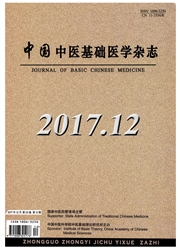

 中文摘要:
中文摘要:
目的:建立脾胃虚弱型肥胖小鼠模型并进行评价。方法:复制高脂饮食诱导肥胖模型,在肥胖模型的基础上按照神疲乏力、食少纳呆、便溏等主要脾虚指标进行二次筛选符合条件的肥胖鼠。通过ELISA法检测血清总胆固醇、甘油三酯、高密度脂蛋白及低密度脂蛋白含量,测定血清中炎症因子(白介素-6、白介素IO及肿瘤坏死因子-α)及脾脏、胸腺和肠道派氏小体中CD4^+、CD8^+及CDllc^+等含量变化。结果:肥胖鼠成模率62.96%,其中脾胃虚弱型肥胖鼠23.53%。脾虚型肥胖鼠IL-10、TNF-α显著高于正常组,白介素石显著低于正常组,其肠道派氏小体中的CD4^+、CD8^+及CDlle^+明显降低。结论:此方法可以较好地筛选出脾胃虚弱型肥胖鼠,为健脾益气治疗肥胖奠定基础。
 英文摘要:
英文摘要:
Objective: To copy and evaluate the spleen deficiency syndrome type in obese mice. Method: Replicating obese mice with high-fat diet, and on this basis, according to the spleen deficient fatigue, less food, stay, loose stools and secondary screening eligible obese mice, and through the ELISA method to detect serum total cholesterol, triglycerides, high-density lipoprotein and low density lipoprotein content, observe serum inflammatory factors ( interleukin 6, interleukin 10 and tumor necrosis factor alpha) and CD4 ~ , CD8 * , CDllc ~ content changes of the spleen, thymus and intestinal corpuscle. Results: The model of obesity mice was 62.96% , 23.53% of which was spleen deficiency syndrome type. The IL-10,the TNF alpha of these mice is significantly higher than normal group, interleukin-6 was significantly lower than normal group. The CD4^+ , CD8^+ and CD11c^+ of their gut peyer' s patch were also significantly reduced. Conclusion: This method could better screen spleen deficiency syndrome by obesity animal medel.
 同期刊论文项目
同期刊论文项目
 同项目期刊论文
同项目期刊论文
 期刊信息
期刊信息
